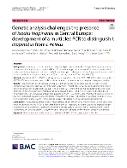| dc.contributor.author | Hrazdilová, Kristýna | |
| dc.contributor.author | Daněk, Ondřej | |
| dc.contributor.author | Hrbatová, Alena | |
| dc.contributor.author | Červená, Barbora | |
| dc.contributor.author | Nosková, Eva | |
| dc.contributor.author | Adamík, Peter | |
| dc.contributor.author | Votýpka, Jan | |
| dc.contributor.author | Mihalca, Andrei Daniel | |
| dc.contributor.author | Noureddine, Mechouk | |
| dc.contributor.author | Modrý, David | |
| dc.contributor.author | Žůrek, Luděk | |
| dc.date.accessioned | 2023-10-31T16:10:28Z | |
| dc.date.available | 2023-10-31T16:10:28Z | |
| dc.date.issued | 2023 | |
| dc.identifier.uri | https://hdl.handle.net/20.500.14178/2058 | |
| dc.description.abstract | Background Ixodes ricinus is an important vector of several pathogens, primarily in Europe. Recently, Ixodes inopinatus was described from Spain, Portugal, and North Africa and then reported from several European countries. In this study, a multiplex polymerase chain reaction (PCR) was developed to distinguish I. ricinus from I. inopinatus and used in the surveillance of I. inopinatus in Algeria (ALG) and three regions in the Czech Republic (CZ). Methods A multiplex PCR on TROSPA and sequencing of several mitochondrial (16S rDNA, COI) and nuclear markers (TROSPA, ITS2, calreticulin) were used to differentiate these two species and for a subsequent phylogenetic analysis. Results Sequencing of TROSPA, COI, and ITS2 separated these two species into two subclades, while 16S rDNA and calreticulin could not distinguish I. ricinus from I. inopinatus. Interestingly, 23 nucleotide positions in the TROSPA gene had consistently double peaks in a subset of ticks from CZ. Cloning of these PCR products led to a clear separation of I. ricinus and I. inopinatus indicating hybridization and introgression between these two tick taxa. Based on a multiplex PCR of TROSPA and analysis of sequences of TROSPA, COI, and ITS2, the majority of ticks in CZ were I. ricinus, no I. inopinatus ticks were found, and 10 specimens showed signs of hybridization. In contrast, most ticks in ALG were I. inopinatus, four ticks were I. ricinus, and no signs of hybridization and introgression were detected. Conclusions We developed a multiplex PCR method based on the TROSPA gene to differentiate I. ricinus and I. inopinatus. We demonstrate the lack of evidence for the presence of I. inopinatus in Central Europe and propose that previous studies be re-examined. Mitochondrial markers are not suitable for distinguishing I. inopinatus from I. ricinus. Furthermore, our data indicate that I. inopinatus and I. ricinus can hybridize, and the hybrids can survive in Europe. | en |
| dc.language.iso | en | |
| dc.relation.url | https://doi.org/10.1186/s13071-023-05971-2 | |
| dc.rights | Creative Commons Uveďte původ 4.0 International | cs |
| dc.rights | Creative Commons Attribution 4.0 International | en |
| dc.title | Genetic analysis challenges the presence of Ixodes inopinatus in Central Europe: Development of a multiplex PCR to distinguish I. inopinatus from I. ricinus | en |
| dcterms.accessRights | openAccess | |
| dcterms.license | https://creativecommons.org/licenses/by/4.0/legalcode | |
| dc.date.updated | 2023-11-07T08:14:10Z | |
| dc.subject.keyword | Tick | en |
| dc.subject.keyword | Ixodes ricinus | en |
| dc.subject.keyword | Ixodes inopinatus | en |
| dc.subject.keyword | 16S rDNA | en |
| dc.subject.keyword | TROSPA | en |
| dc.subject.keyword | COI | en |
| dc.subject.keyword | ITS2 | en |
| dc.subject.keyword | Algeria | en |
| dc.subject.keyword | Czech Republic | en |
| dc.relation.fundingReference | info:eu-repo/grantAgreement/UK/COOP/COOP | |
| dc.relation.fundingReference | info:eu-repo/grantAgreement/MSM//LX22NPO5103 | |
| dc.date.embargoStartDate | 2023-11-07 | |
| dc.type.obd | 73 | |
| dc.type.version | info:eu-repo/semantics/publishedVersion | |
| dc.identifier.doi | 10.1186/s13071-023-05971-2 | |
| dc.identifier.utWos | 001083412600001 | |
| dc.identifier.eidScopus | 2-s2.0-85173345918 | |
| dc.identifier.obd | 637969 | |
| dc.identifier.pubmed | 37814284 | |
| dc.subject.rivPrimary | 10000::10600 | |
| dcterms.isPartOf.name | Parasites & Vectors | |
| dcterms.isPartOf.issn | 1756-3305 | |
| dcterms.isPartOf.journalYear | 2023 | |
| dcterms.isPartOf.journalVolume | 16 | |
| dcterms.isPartOf.journalIssue | 1 | |
| uk.faculty.primaryId | 115 | |
| uk.faculty.primaryName | Přírodovědecká fakulta | cs |
| uk.faculty.primaryName | Faculty of Science | en |
| uk.faculty.secondaryId | 111 | |
| uk.faculty.secondaryName | Lékařská fakulta v Plzni | cs |
| uk.faculty.secondaryName | Faculty of Medicine in Pilsen | en |
| uk.department.primaryId | 1038 | |
| uk.department.primaryName | Katedra parazitologie | cs |
| uk.department.primaryName | Department of Parasitology | en |
| uk.department.secondaryId | 100012968318 | |
| uk.department.secondaryName | Biomedicínské centrum | cs |
| uk.department.secondaryName | Biomedical Center | en |
| dc.type.obdHierarchyCs | ČLÁNEK V ČASOPISU::článek v časopisu::původní článek | cs |
| dc.type.obdHierarchyEn | JOURNAL ARTICLE::journal article::original article | en |
| dc.type.obdHierarchyCode | 73::152::206 | en |
| uk.displayTitle | Genetic analysis challenges the presence of <em>Ixodes inopinatus</em> in Central Europe: Development of a multiplex PCR to distinguish <em>I. inopinatus</em> from<em> I. ricinus</em> | en |

